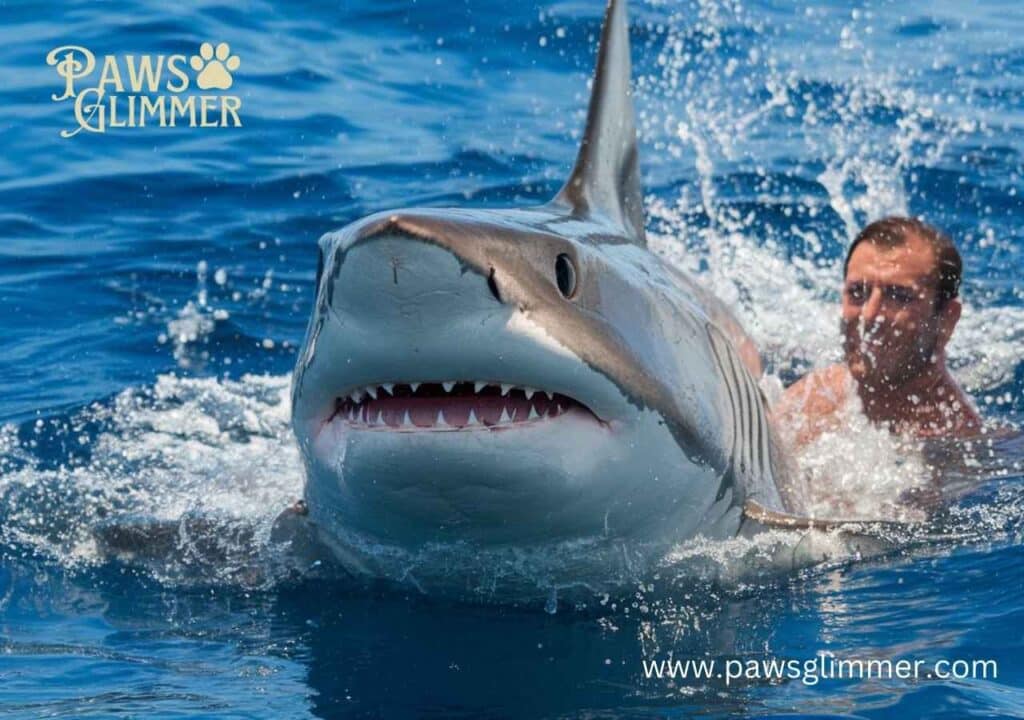The mysterious world of ocean predators has always captivated our imagination, with mako sharks and human encounters standing out as particularly fascinating. These powerful creatures, known for their incredible speed and acrobatic abilities, often raise questions about their interactions with humans. This comprehensive guide dives into the reality behind mako shark encounters, separating fact from fiction about these remarkable marine species and shedding light on their behaviors and the risks involved.
What Is a Mako Shark?

The mako shark, specifically the shortfin mako (Isurus oxyrinchus), represents one of the ocean’s most perfectly designed predators. These pelagic fish possess a streamlined, torpedo-shaped body that allows them to reach speeds of up to 45 miles per hour, making them the fastest shark species in the world. Their metallic blue coloring and white underside create perfect camouflage in the open ocean.
In the realm of marine species, makos stand out with their distinctive features: large black eyes, pointed snout, and crescent-shaped tail fin. These adaptations have evolved over millions of years, making them incredibly successful hunters in their natural habitat.
Most Interesting About Do Emus Attack Humans?
Behavior and Characteristics
Shark behavior patterns show that makos are incredibly sophisticated hunters. Unlike many other sharks that rely solely on smell, makos use their superior vision and advanced sensory capabilities to track prey. Their behavior in the deep waters demonstrates remarkable intelligence, especially when pursuing fast-moving prey like tuna and swordfish.
The most striking characteristic of mako sharks is their ability to maintain a body temperature higher than the surrounding water, a rare trait among fish. This endothermic capability allows them to hunt in colder marine environments and pursue prey for extended periods.
Do Mako Sharks Attack Humans?

When examining human encounters with mako sharks, it’s crucial to understand that these interactions are exceptionally rare. Most marine encounters occur in offshore waters where these sharks naturally roam. While makos possess impressive hunting capabilities, they don’t typically view humans as prey, focusing instead on their natural diet of fast-moving pelagic fish.
The relationship between makos and humans primarily revolves around fishing activities, where most documented interactions take place. These encounters usually happen when anglers attempt to land these powerful ocean predators, rather than during recreational swimming or diving.
Addressing Concerns with Yellow Dog Poop
1. Shark Attacks: A Rare Occurrence
Statistics from the International Shark Attack File (ISAF) reveal that mako shark attacks on humans are extremely uncommon. Between 1980 and 2024, there have been fewer than 10 confirmed unprovoked attacks worldwide. This number is remarkably low considering the extensive marine environments these sharks inhabit.
2. Why Do Mako Sharks Attack Humans?
Most mako shark encounters involving defensive behavior occur when these animals feel threatened or are provoked. The majority of incidents happen during fishing activities when the sharks exhibit protective actions while being caught or released. These situations don’t represent natural predatory behavior but rather defensive responses to perceived threats.
3. Are Mako Sharks Aggressive?

While makos display powerful predator actions, their aggression is typically directed toward prey species. In their natural habitat, they exhibit complex hunting patterns that rarely involve humans. However, their speed and agility can make them appear more intimidating than other shark species.
4. Documented Incidents
Recent contact incidents with mako sharks have been carefully documented by marine researchers. Between 2020-2024, most recorded encounters involved fishing vessels in offshore waters. A notable case from 2023 occurred off the California coast, where a mako shark leaped into a fishing boat – a behavior characteristic of this species when hooked.
The Top 20 Animals with Big Foreheads
5. Can Humans Avoid Mako Shark Attacks?
Understanding marine habits helps prevent unwanted encounters. Staying informed about fishing regulations and avoiding areas where fishing activities attract these sharks significantly reduces risk. Professional divers and researchers recommend maintaining awareness of your surroundings in deep waters.
Dangers to Anglers

The primary risk to humans comes from recreational and commercial fishing interactions. Anglers face particular challenges when dealing with hooked makos, as these powerful marine species can become extremely energetic during capture attempts. Their strength and agility make them especially dangerous when brought alongside boats.
Professional fishermen emphasize the importance of proper safety equipment and protocols when targeting or accidentally hooking these powerful predators. Many experienced anglers report that proper handling techniques and respect for the animal’s power are crucial for safe interactions.
Mako Sharks Can Jump Into Boats
One of the most spectacular and dangerous aspects of mako shark behavior is their ability to leap completely out of water. These ocean predators can jump up to 20 feet high, sometimes landing in boats. This behavior, known as breaching, usually occurs during hunting or when the shark is hooked.
Scientists believe this jumping ability helps makos catch fast-moving prey in their natural habitat. However, this impressive capability can pose risks to smaller fishing vessels and their crews.
Can Dogs Eat Salt and Vinegar Chips?
Biting Hands or Gear Boats
When dealing with hooked makos, their powerful jaws and defensive behavior can cause significant damage to fishing gear and vessels. Their teeth are perfectly adapted for grasping and cutting, making them capable of severe injury if proper precautions aren’t taken.
Mako Shark Bite Risks and Prevention

Understanding marine encounters with makos requires knowledge of proper safety protocols. These sharks possess incredible bite force, estimated at over 3,000 pounds per square inch. Their razor-sharp teeth and powerful jaws make any bite potentially serious. However, following established safety guidelines significantly reduces risk during human encounters.
Prevention strategies include avoiding areas with active fishing, staying alert in open ocean environments, and maintaining proper distance if a mako is spotted. Professional dive operators and fishing charters typically carry specialized safety equipment and follow strict protocols when operating in mako territories.
Are Mako Sharks More Dangerous than Great White Sharks?
Comparing these two ocean predators reveals interesting distinctions. While great whites are responsible for more recorded attacks, mako sharks present unique challenges due to their speed and agility. Their different hunting patterns and habitats affect how they interact with humans.
Table: Mako vs Great White Comparison
| Characteristic | Mako Shark | Great White |
|---|---|---|
| Top Speed | 45 mph | 35 mph |
| Habitat | Open ocean | Coastal/Open water |
| Attack Records | <10 unprovoked | >300 unprovoked |
| Typical Behavior | Offshore/Pelagic | Coastal/Migratory |
Can Mako Sharks Be Friendly?

While “friendly” isn’t an accurate term for any wild predator, makos show interesting behavioral patterns in their natural habitat. Marine biologists studying these sharks have observed complex social behaviors and remarkable intelligence. Their interactions with humans in controlled research settings demonstrate they can be more predictable than previously thought.
Recent studies of mako shark behavior suggest they’re capable of learning and adapting their responses to repeated situations, showing they’re not merely instinct-driven creatures.
Mako Sharks and Their Diet

In their marine ecosystems, makos are apex predators with sophisticated hunting strategies. Their diet primarily consists of fast-swimming fish like tuna and swordfish, demonstrating their remarkable hunting abilities in pelagic zones. These sharks have evolved specific feeding patterns that make them incredibly successful in their ecological niche.
Mako Shark Conservation
The status of mako sharks in our marine ecosystems has become increasingly concerning. Conservation efforts face significant challenges due to ongoing commercial fishing pressures. Current data shows alarming declines in shark population numbers, particularly in the North Atlantic region where fishing pressure is highest.
Recent protection measures implemented between 2020-2024 include stricter fishing regulations and international agreements to limit harvest. These conservation measures are crucial for maintaining healthy ocean environments and ensuring the survival of this remarkable species.
Final Verdict
After examining extensive research and documented human encounters, we can conclude that while mako sharks possess remarkable capabilities as ocean predators, they don’t deserve their fearsome reputation regarding human interactions. Their presence in marine biomes is essential for maintaining healthy ocean ecosystems.
The key to coexisting with these magnificent creatures lies in understanding their behavior and respecting their natural habitat. Most negative encounters can be avoided through proper education and adherence to safety guidelines.
FAQs
Are Mako sharks the fastest sharks?
Yes, makos are the fastest of all shark species, capable of reaching speeds up to 45 mph in short bursts. This remarkable speed helps them chase down swift prey in open ocean environments.
How big do Mako sharks get?
Adult makos typically reach lengths of 10-12 feet and weights up to 1,200 pounds. Females generally grow larger than males, demonstrating the species’ sexual dimorphism in their marine environment.
What do Mako sharks typically eat?
In their natural habitat, makos primarily feed on fast-swimming fish including tuna, swordfish, and other pelagic fish. Their diet reflects their superior hunting abilities and position as top ocean predators.
How can you tell if a shark is about to attack?
Warning signs include unusual shark behavior such as rapid changes in direction, lowered pectoral fins, and increased swimming speed. However, most mako encounters don’t result in aggressive behavior unless the shark feels threatened.
Are Mako sharks endangered?
According to recent conservation measures and studies, shortfin mako sharks are classified as endangered. This status results from commercial fishing pressure and slow reproduction rates. Current protection measures aim to help their population recover through strict fishing policies and international cooperation.
Conclusion: Do Mako Sharks Attack Humans?
While mako sharks are powerful apex predators and among the fastest sharks in the ocean, unprovoked attacks on humans are extremely rare. There have only been 10 unprovoked attacks attributed to mako sharks in the International Shark Attack File, one of which was fatal. Most mako shark encounters with humans occur when the sharks are caught by fishermen or during diving activities.
Unlike some other shark species, makos don’t actively seek out human prey. Their diet consists mainly of fish, squid, and other marine mammals. However, they are known for their aggressive behavior when hooked or cornered, which can pose risks to fishermen. Their speed (capable of bursts up to 45 mph) and strength make them particularly dangerous in these situations.
Key takeaway: While mako sharks have the capability to harm humans and should be treated with appropriate caution, they are not typically a threat to humans in normal circumstances, with very few documented unprovoked attacks throughout history.Copy

“With four years of experience in animal blogging, I delve into the fascinating world of animals, exploring their behaviors, relationships with humans, and the complexities of coexistence. As the author of Paws Glimmer, I provide in-depth insights on everything from understanding animal instincts to identifying species that pose risks to humans. My mission is to inform and foster respect between humans and animals, promoting safer, more aware interactions.”







